Movie Review By: SFAM
Year: 2004
Directed by: Alex Proyas
Written by: Jeff Vintar & Akiva Goldsman, based on book by Isaac Asimov
IMDB Reference
Degree of Cyberpunk Visuals: High
Correlation to Cyberpunk Themes: High
Key Cast Members:
Sonny: Alan Tudyk
Del Spooner: Will Smith
Susan Calvin: Bridget Moynahan
Dr. Alfred Lanning: James Cromwell
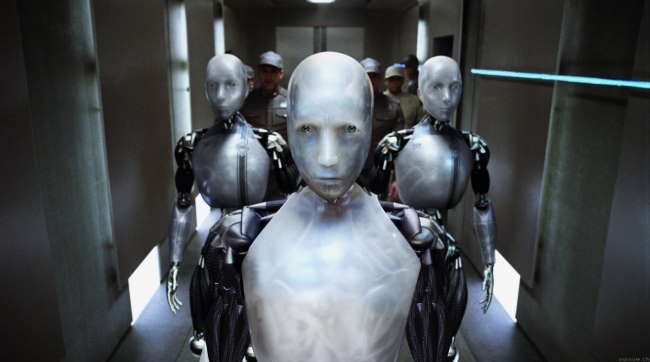
The Three Laws of Robotics
1. A robot may not injure a human being, or, through inaction, allow a human being to come to harm.
2. A robot must obey orders given it by human beings, except where such orders would conflict with the First Law.
3. A robot must protect its own existence as long as such protection does not conflict with the First or Second Law.
Overview: Superficially based on Asimov’s great collection of short stories - “I, Robot” – this movie of the same name usually sacrifices intelligent Sci-Fi for overblown summer blockbuster clichés. While Asimov fans will recognize the names of Dr. Alfred Lanning, Dr. Susan Calvin and Lawrence Robertson, they won’t recognize the characters that Proyas gives us. In yet another, “The evil robots are coming to control us” movie. I, Robot delivers eye-popping, often well over-the-top FX from beginning to end. Right at the beginning, I, Robot relays to us that they’ve set the bar low by spending the first five minutes delivering Converse Shoe and Fed-ex Delivery commercials. Still, I, Robot captures enough of the essence to make it enjoyable cyberpunk viewing. Asimov’s three rules are still in play here, and Sonny, the robot, actually makes it interesting.
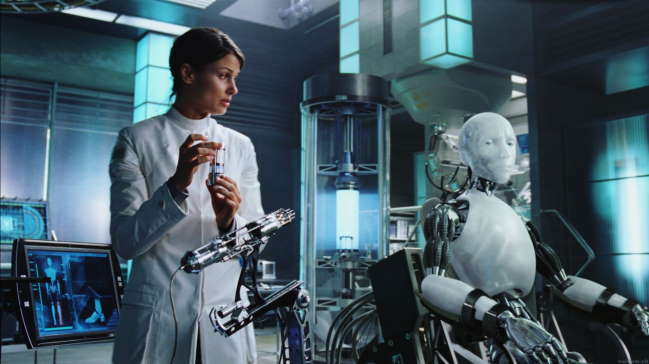
The Story: In the near future (2035), robots are a pervasive fact of life, and serve humans in a variety of capacities. US Robotics, maker of the fabled “NS” series of robots is just about ready to release their greatest innovation, the NS5 robots. NS5 robots are the most lifelike to date, and are destined to replace the ultra-reliable but outmoded NS4 model. The NS5s are guaranteed to stay new by receiving daily updates from US Robotics’s master AI system, “V.I.K.I.”
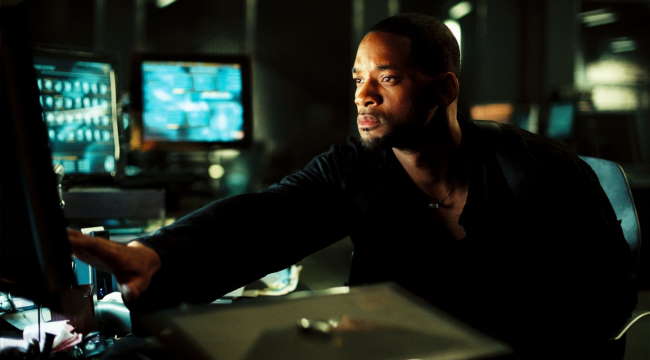
The week of the release, Dr. Alfred Lanning (James Cromwell), the founder of modern robotics dies in an apparent suicide. He leaves a clue behind for former patient and police officer Del Spooner (Will Smith). Del Spooner has reasons to hate and mistrust robots and immediately suspects foul play. US Robitics CEO Lawrence Robinson (Bruce Greenwood) is suspicious looking, and things just “feel” right.
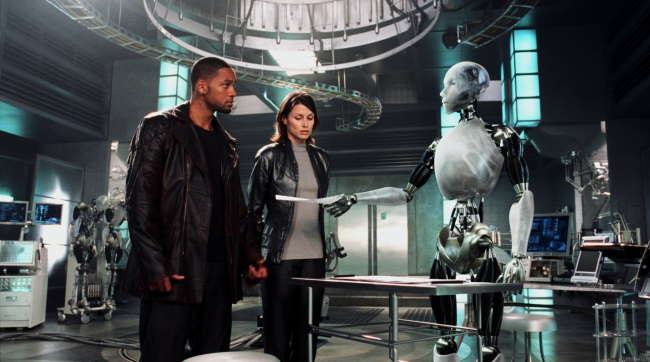
Assisted by robot psychologist, Dr. Susan Calvin (Bridget Moyanahan), Del finds an NS5 robot named Sonny, who appears to have freewill developed life-like features – so much that Del suspects Sonny of having killed Dr. Lanning. In following the breadcrumbs, Dels fears are realized – the robots do not seem to be adhering to the thee Laws of Robotics. Now they must race to uncover the real nature of the plot before the trap is sprung.
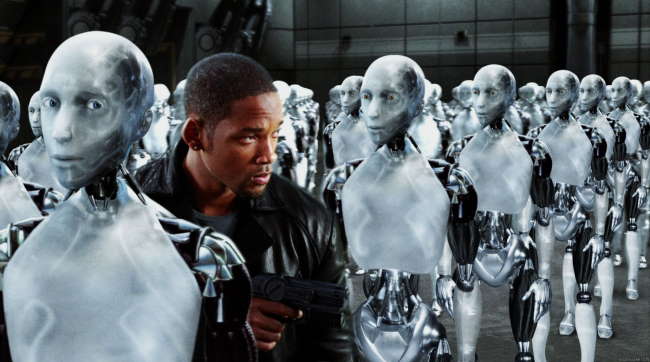
Will Smith Plays “Will Smith”…Again: You know the role – cocky, argumentative, underdog tough-guy cop – Be it MIB, ID4 or I, Robot, Will Smith plays the same old Will Smith. I, Robot was clearly green-lighted to bring in the teens to the seats over the summer – Will Smith is the guy to do this. Will Smith and massively cool FX = ROI. Unfortunately, it also engenders a far crappier story. Had we gotten an introspective no-name person in Smith’s role, we might have had a significantly higher degree of realism. But then again, realism would imply that things like the overblown US Robots Truck bashing scene wouldn’t have been included.

Sonny: If not for Sonny, I, Robot would be almost unwatchable. Sonny (voiced by Serenity star, Alex Tudyk) provides us an investigation into android humanity similar to Star Trek’s Data in his better moments. While some of it comes off as sappy, Sonny’s questioning of his right to exist, and more interestingly, his hopes that others consider him a being instead of an it provide the best moments of the movie. One can only wonder how much better I, Robot would have been if this aspect of the movie was highlighted vice the focus on Will Smith and the overblown FX scenes.
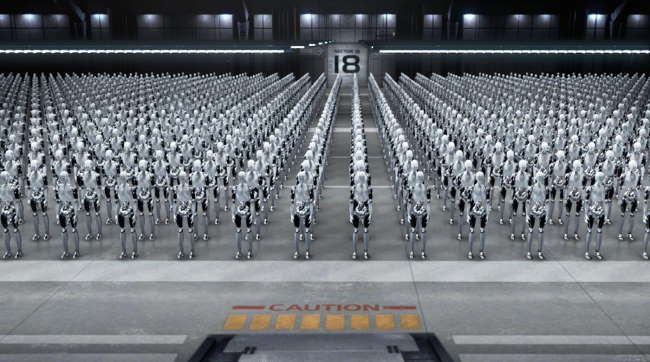
“There have always been ghosts in the machine – random segments of code that have grouped together to form unexpected protocols. Unanticipated, these free radicals engender questions of free will, creativity, and even the nature of what we might call the soul. Why is it that when some robots are left in the dark they will seek the light? Why is it that when robots are stored in an empty space they will group together rather than stand alone? How do we explain this behavior? Random segments of code? Or is it something more? When does a perceptual schematic become consciousness? When does a difference engine become the search for truth? When does a personality simulation become the bitter moat of the soul?”
Evolution of The Three Laws: I, Robot touches on some interesting questions concerning the three laws. If, taken to their logical extreme, do the laws imply, similar to Colossus: The Forbin Project, that machines should consider removing our freewill in order to protect us? Also, given a set of operating conditions that include the ability to learn from the environment, are we truly sure that machines would not eventually develop sentience and freewill? This is especially problematic when science has yet to deliver a definitive statement on how this comes about.

The FX: Yes, I, Robot delivers awesome android FX – continually so, in fact. The mandatory overblown chase scenes, massive explosions and lots of gun fighting are all there, but so are the robots. And the robots are simply amazing. Their facial expressions are lifelike, their exoskeleton muscles look believable, and their demeanor seems perfect. However, their cartoon-like ability to jump as high and far as they like is well past over-the-top. Worse, not all of the NS5s are equal, as near the end they transform into bumbling fools, where an army of them seems unable to stop two humans in possession of guns that never run out of ammo.

The Bottom Line: One wonders how great I, Robot could have become had the studios given Dark City director Proyas more of a free hand in its development. Instead, I, Robot is a summer blockbuster first, and an interesting cyberpunk movie second. Still, Sonny and the robot FX raises I, Robot to be more interesting and enjoyable than it has rights to be. The performances of the leads are pretty much all lackluster – make no mistake – Sonny is the star here, and dominates the screen during every appearance he makes. Normally I give overblown summer blockbusters with great FX five or six stars – Sonny, and the wonderful ending visual makes I, Robot deserve a bonus star.
~See movies similar to this one~
Year: 2004
Directed by: Omar Naim
Written by: Omar Naim
IMDB Reference
Degree of Cyberpunk Visuals: Low
Correlation to Cyberpunk Themes: Medium
Key Cast Members:
Alan W. Hakman: Robin Williams
Delila: Mira Sorvino
Fletcher: James Caviezel
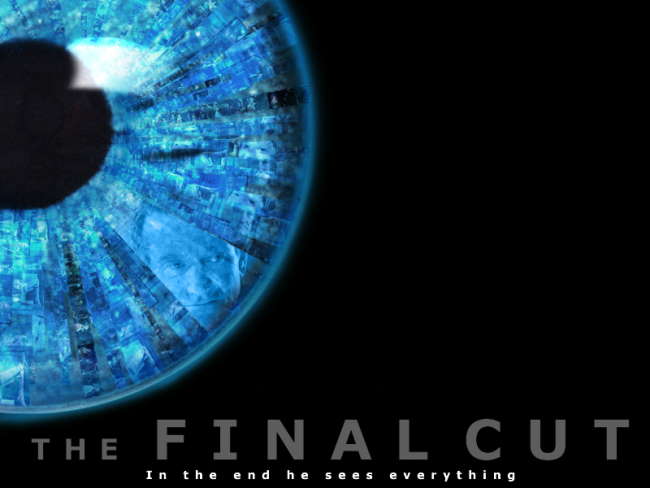
Overview: Overview: Sometimes we find a movie that has an idea so intriguing that it just can’t fail to be great – yet the director still finds a way to screw it up. The Final Cut is this kind of movie. The Final Cut explores the idea, “If every moment of your life was recorded on camera, would you live differently?” While you might expect a focus on the changes to society this technology engenders, instead, it turns out that the entire purpose of a camera implanted in you at birth is to have a paltry video “rememory” of your life at your funeral!!!! Gee, wow – yeah, that’s what I’d do with that technology – screw up my whole life so that people at my funeral can be bored to death with even MORE home movies!
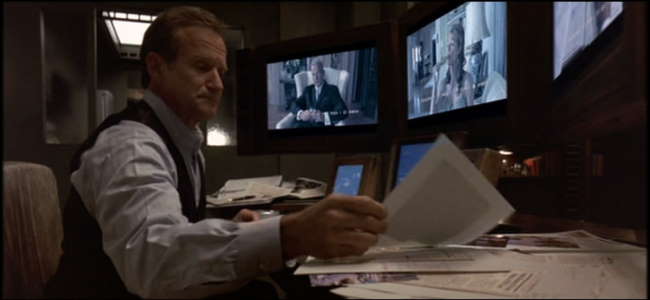
Cutter Code of Ethics
i. A Cutter cannot sell or give away Zoe footage
ii. A Cutter cannot have a Zoe implant.
iii. A Cutter cannot mix Zoe footage from different lives for a Rememory.
The Story: The Final Cut takes place in a near future scenario that looks almost exactly like the present, with one exception – a technology that can be implanted directly into the eyes prior to birth is now in vogue. The purpose of this technology, created by the Zoe corporation, is to record your life so that upon your death, a “Cutter” can compose a “rememory” of your life to immortalize you for all time. This “Rememory” isn’t really representative of someone’s actual life, but is instead a compilation of how the family members “want” to remember you (hence, the term “rememory”). Alan Hakman, played by Robin Williams, is a Cutter-extraordinaire. He is brought in by family members when the deceased was a major scumbag in real life. His job is simple – he must take the available memories and “compose” a final cut of their life that leads everyone to think this scumbag was actually a saint.
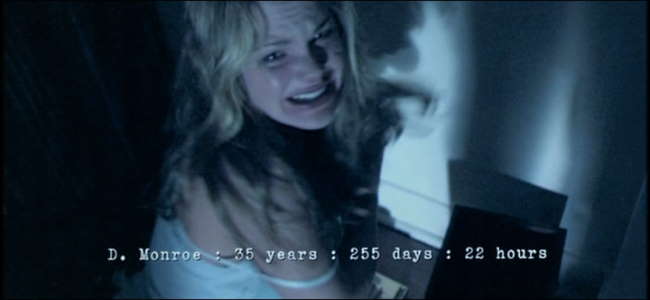
Unfortunately for Alan, his latest rememory scumbag – a child molester – is high profile enough that there are people looking to gain access to this guy’s memories. Alan is in danger of breaking one of the rules of the Cutter oath (a Cutter cannot sell or give away Zoe footage). Worse, in viewing the footage, Alan sees a childhood friend who he thought he accidentally killed dead long ago. Now horrible memories of Alan’s childhood come crashing back – so strong that he can’t help but investigate. And in the process of doing so, Alan realizes he may have broken another more critical Cutter law.
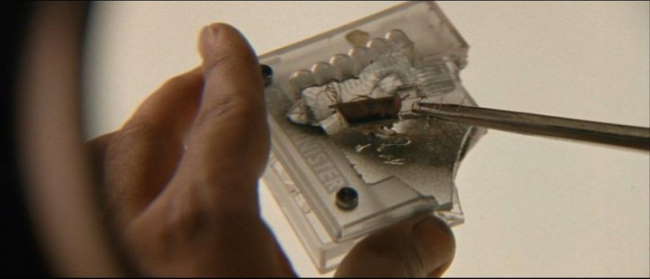
The Use of the Technology: The most annoying part of The Final Cut is the idea that a technology this powerful would only be used to compose a home movie at a funeral. This simply doesn’t pass common sense muster. Even if the Zoe Corporation wouldn’t allow scans of the technology when alive, a groundswell of techy-hacker types would find a way to do this. More likely, a technology such as this would be accessed by people on a regular basis. An audio-video record of everything you see could spurn all sorts changes in society. While the Final Cut touches on the change in personal interaction, this becomes hard to believe if the only implication is that someone’s entire life will be boiled into a 30 minute slice at the funeral. I mean, what are the chances that anything incriminating would show up there, especially if the job of a Cutter is to suppress all the juicy sleazebag stuff? Again, terrific idea with lots of promise – but the Final Cut almost completely wastes it.

“My job is to help people remember what they want to remember.”
The Acting: Even though the script is hurting in this movie, Robin Williams turns in a terrific, if sedated performance. He really adds credibility to a plot that otherwise could have been horribly received. Unfortunately, Mira Sorvino in a supporting role really isn’t given enough to have the chance of making much of an impact. James Caviezel does turn in a cool performance as a conflicted bad guy.
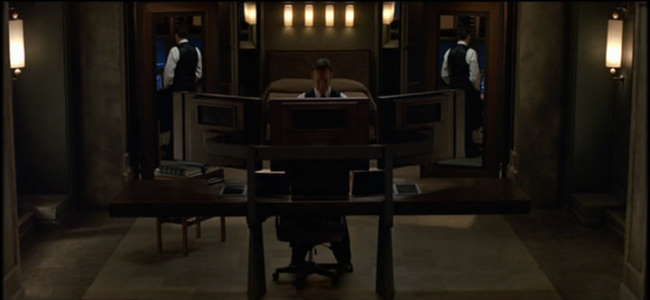
The Bottom Line: Visually, there is little interesting about The Final Cut. Thematically, the movie is frustrating in that it had the potential to be very interesting. Fortunately for the viewers, Robin Williams flat out rescues the Final Cut from mediocrity to the point that you still will care enough about the technology to spend a moment or two thinking about it’s potential impact on society. And truly, regardless of the plot holes in this film, the technology concepts are just not that far-fetched. In an age where RFID chips are already being implanted in people, a microscopic video camera integrated into the eyes tied to a micro-hard disk may not be that far away. This “very-near” future potential adds credibility to the visuals which generally show a current society. If you are interested in thinking through the potential impact of technology such as this, The Final Cut is a decent watch. If you like Robin Williams, it’s a MUST SEE movie. Otherwise, you can probably make it through life without giving the Final Cut a viewing.
~See movies similar to this one~
Tags: Movie Review
Year: 2003
Directed by: David Barto
Written by: Brad Mirman
IMDB Reference
Degree of Cyberpunk Visuals: Low
Correlation to Cyberpunk Themes: Low
Key Cast Members:
Norman Scott: Christopher Lambert
Walters: Lou Diamond Phillips
Claire: Kelly Brook
Murchison: Ron Perlman
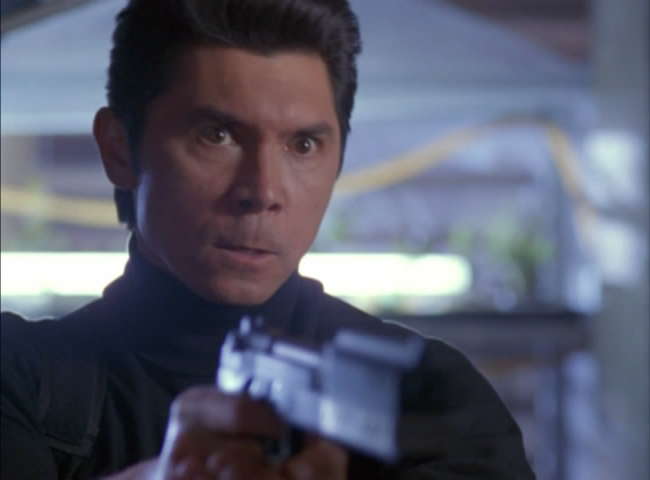
Overview: You know things aren’t going to be great when a movie copies Highlander 2 for its larger plot points. Absolon never had delusions of being good. It’s derivative from the get go. That said, while the plot, story and dialogue suck, at least Absolon has Christopher Lambert, Ron Perlman, Kelly Brook, and Lou Diamond Philips, who gives an especially good performance.
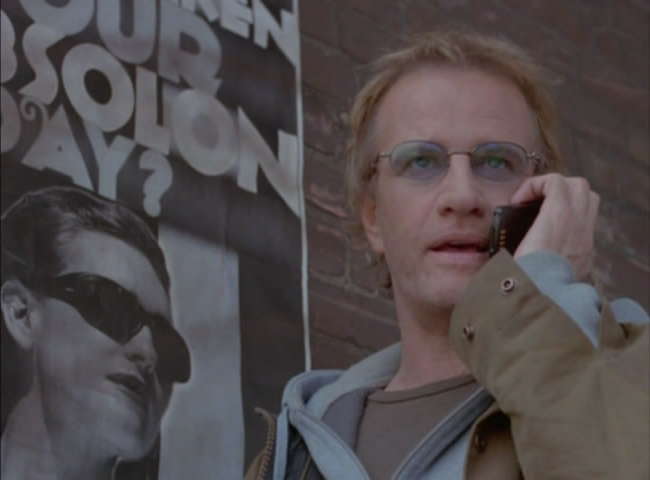
The Story: In a near-future dystopia, a virus has infected everyone on the planet, and has killed off millions. In saving mankind, a drug named Absolon has been developed which combats the virus. Unfortunately, it must be taken every day. One corporation, headed by Ron Perlman, owns Absolon and now controls the fate of mankind. Everyone must line up daily at distribution centers to receive their “fix,” otherwise they run the risk of developing to phase II of the disease, and are then incurable.
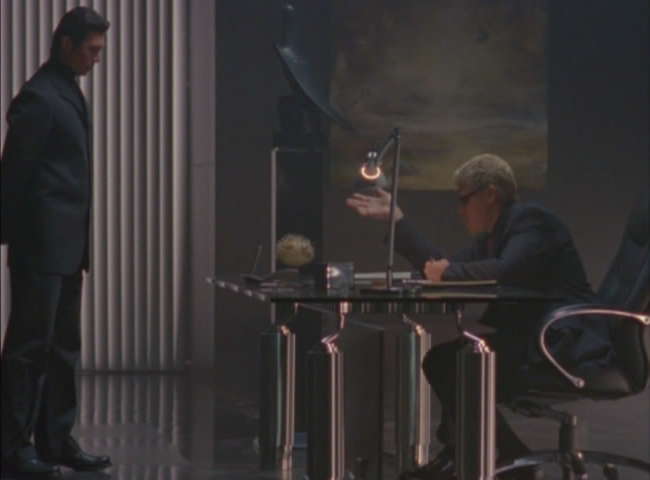
Finally, a “real” cure for the virus has been developed, but for obvious reasons, the stereotypical evil corporation who owns Absolon doesn’t want their market share challenged, so the inventor is murdered and they attempt to bury the cure. Lou Diamond Phillips, who turns in by FAR the best performance here, is Perlman’s “tough guy” responsible for “taking care” of the problem. Lambert plays a grizzled cop who inadvertently stumbles on the cover-up, and subsequently becomes emeshed in the “resistence.” Along with Kelly Brook, who worked on the cure, Lambert tries to rescue the cure so that humanity can escape the inhumanity that Absolon engenders.
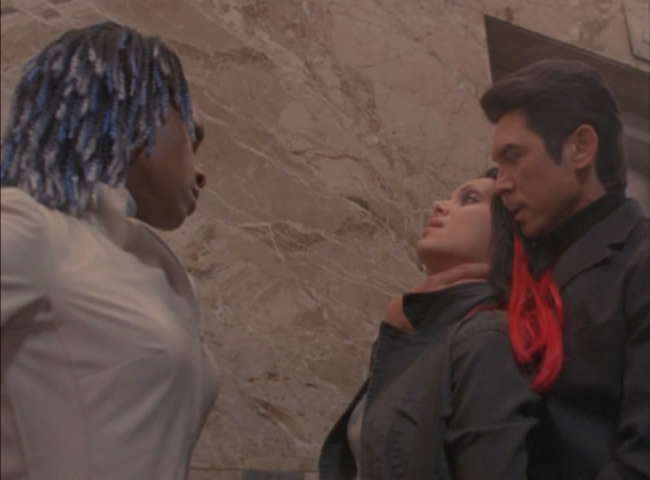
The Bottom Line: Other than Lou Diamond Phillips’ performance, there’s nothing quality about Absolon. The story, the cheapy matrix FX, the set pieces, the dialogue and the pacing all pretty much suck. I must say though, I’m a real sucker for Christopher Lambert, and it’s been a while since I’ve seen Phillips put in a decent performance. For this reason, I’ll raise Absolon from 3 stars (where it probably belongs) to a 4 star review.
~See movies similar to this one~
Tags: Movie Review
Year: 2003
Directed by: Jonathan Mostow
Written by: John D. Brancato & Michael Ferris (story & screenplay), Tedi Sarafian (story)
IMDB Reference
Degree of Cyberpunk Visuals: High
Correlation to Cyberpunk Themes: Medium
Key Cast Members:
Terminator: Arnold Schwarzenegger
T-X: Kristanna Loken
John Connor: Nick Stahl
Kate Brewster: Claire Danes
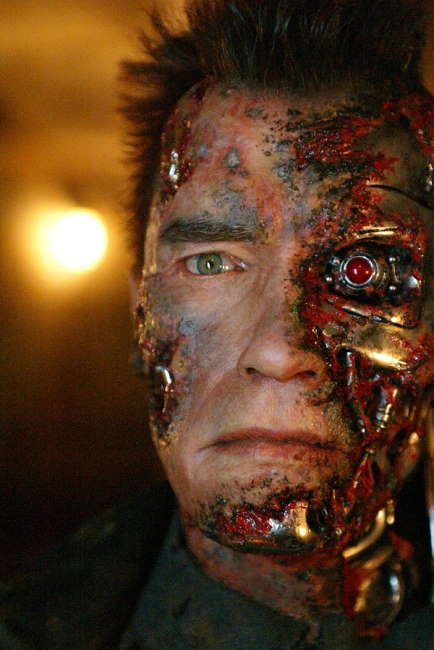
Overview: What happens if you take the original Terminator idea, morph it with T2, get rid of any semblance of a coherent, cool story, but add a really hot chick in leathers kicking butt to it? Answer: Terminator 3: Rise of the Machines! Director Jonathan Mostow really kicks the FX up a notch, but unfortunately, the story fades into more of a prop than the centerpiece it was in the first two movies. While the key cast members are all fine (terrific in the case of Lokken), they can only work with what they’re given.
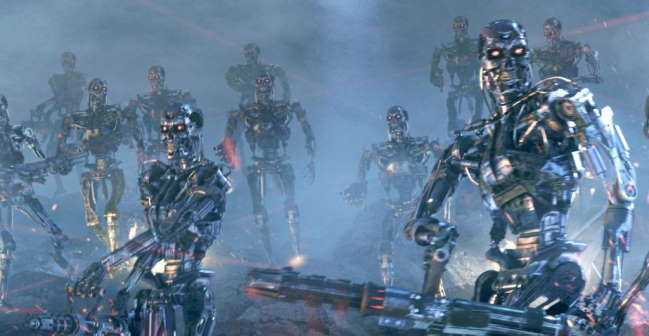
The Story: In Terminator 3, 10 years have passed since John and Sarah Conner destroyed Cyberdyne Systems and stopped the Skynet apocalypse. Unfortunately, it seems that the future is not what we make of it (As Desirina reminds us in the T2 comments), instead, fate is now predetermined. Why? Who knows…roll with it, buddy. You’ll get no well thought philosophical time travel notions here. Instead, the Terminator mystique is just that – a façade to get us to the juicy action sequences!
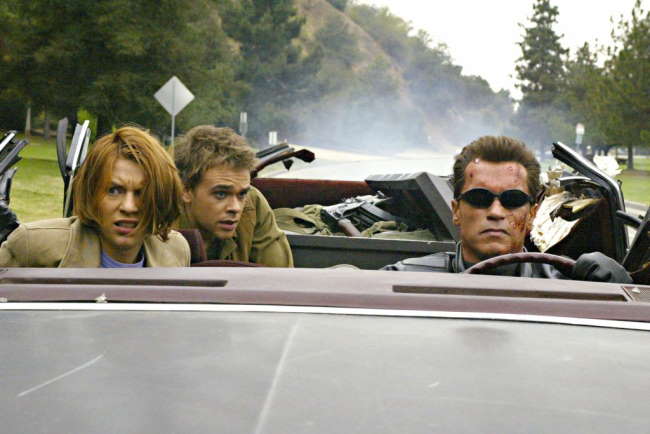
Over the years, John Conner (Nick Stahl) has turned into a drifter – he never really believed that the end of the world was abated, so he has spent his life leaving no clues as to his existence (no phones, bank accounts, and FORGET that damn phonebook!). He wrecks on his motorcycle, and due to his fear of hospital records, decides instead to break into a local veterinarian’s office and take some random medicine in the hopes that it’s a pain reliever (apparently, in the future time of 2003 the west has forgone local clinics that treat illegal aliens without recording their names and addresses). It just so has it that Conner has broken into a vet where Kate Brewster (Claire Danes), a former junior high fling of Conner’s, works.
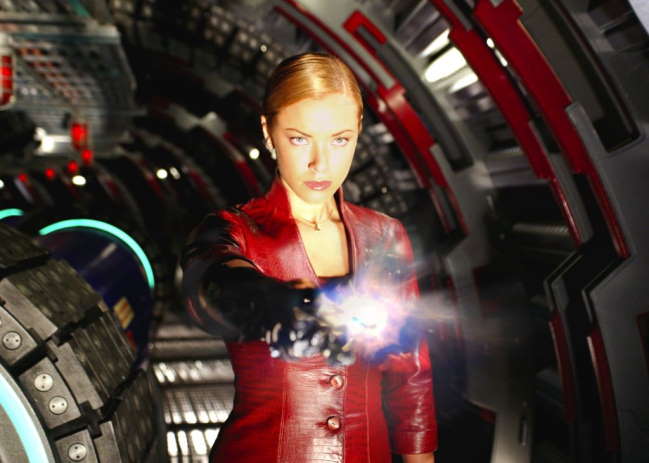
While this is going on, The TX (Kristanna Loken), or Terminatrix as Conner refers to her, arrives from the future. The new Terminatrix is nanotechnology enabled, and can control all computer networks and most electrically powered machines - in short, she’s a badass. Because Conner has all but disappeared, her mission is to bump off his lieutenants, and if possible, to then locate and terminate Conner. Arnold Schwarzenegger as the obselete CYberdyne Systems 101 model is once again captured in the future and dispatched in an attempt to save John Conner, and his future wife from the nuclear holocaust, and if possible, protect them from the Terminatrix.
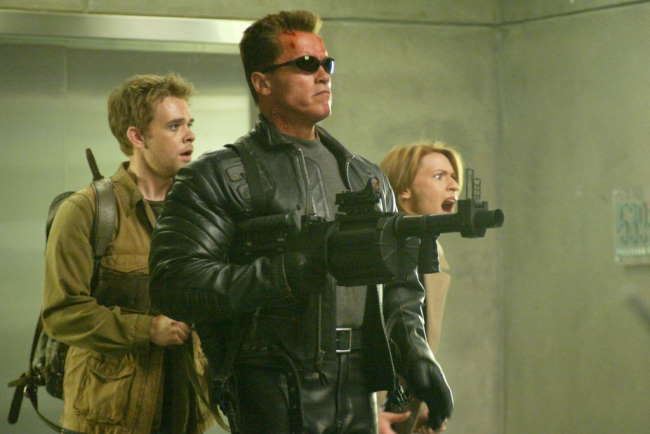
Philosophical Problems: I understand the desire to “go to the well” once more in the Terminator series, but it seems like they could have been a little more sophisticated in how they went about it. For instance, why, if Skynet is going to keep sending Terminators from the future, doesn’t it send them all back to 1984? Even a little throwaway line, similar to Star Trek’s magical matter-anti-matter converter, telling us that this isn’t possible would have helped this. Also, there’s the problem that Skynet’s grid was smashed in T1 – which was the whole purpose for the last ditched desparate attempt at a retroactive abortion. If the grid has been smashed (which if Skynet is an AI, what does this even mean?), how is it that Skynet can keep on producing newer Terminator models? Clearly, things are going all that badly for Skynet. I almost envision Skynet being in it’s “last throes” as similar to another conflict in today’s time.
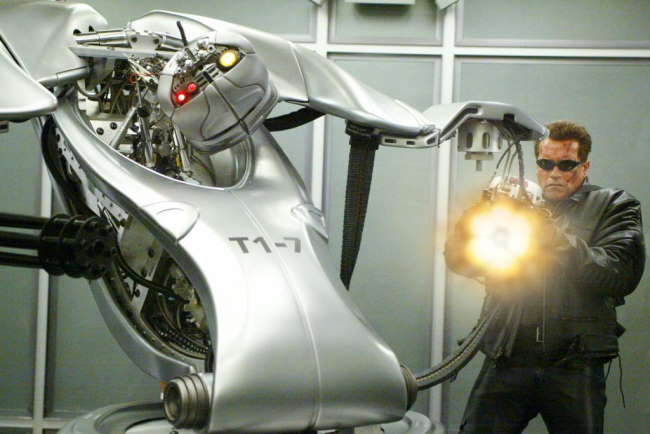
In T3, we get to see the first model Terminator.
More harmful than the problems above is the issue of fate being predetermined. Um, OK, sure, I suppose it could be, but couldn’t they have tried to justify this a bit more? The Original Terminator provided us a wonderfully nuanced time loop; Terminator 2 at least still kept a pretty solid story with the idea that the future is what we make of it. Terminator 3 basically says, “Fuck it. You’ll all screwed anyways, so lets just throw down!” And throw down they do.
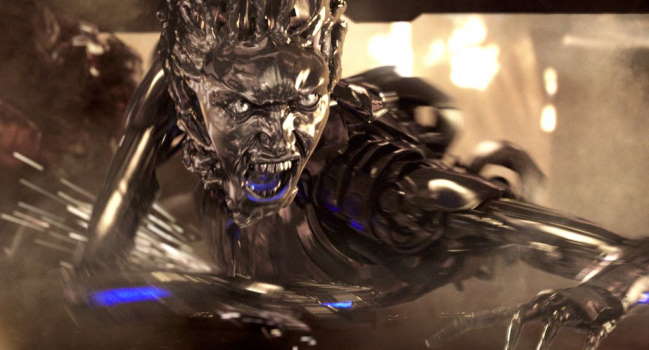
The FX: Although the story takes a significant hit in T3, the special effects do indeed rock in an over-the-top sort of fashion. I thought the truck-car race was a bit too over-done, but I LOVED the Terminatrix’s FX. And truly, Kristanna Lokken played her wonderfully. I loved her facial expressions and demeanor. She knew what the part was supposed to deliver (a hot android terminator chick kicking ass) and did it wonderfully. The FX surrounding her from beginning to end are reason enough to watch this movie.
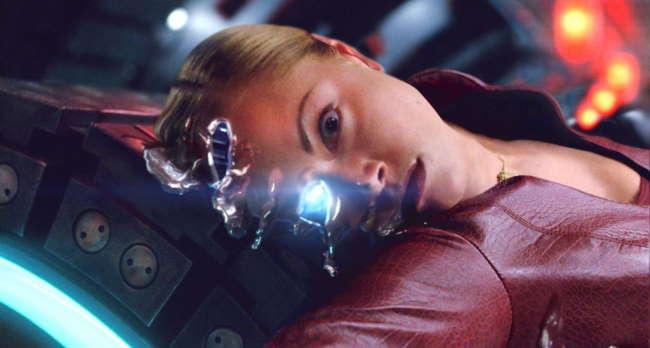
The Bottom Line: While this movie rates highly as a “hot chick kicking butt” flick, it suffers in comparison to its two predecessors as the ending to a trilogy. Terminator 3 certainly was enjoyable, but not in the sophisticated sense that the first or second one was. The sliding scale I see with this series is as follows: Terminator had an awesome story and pretty great visuals for its time; Terminator 2 delivered a very good story, and provided awesome visuals – the type that raise the bar on future movies; The third does away with the cool story but at least still delivers the visuals. In short, Terminator 3: Rise of the Machines is a bubble-gum chewing summer blockbuster, pure and simple. But on that level it works fine. However, based on the downward quality trend, if Abbot & Costello were still alive, I’d say that the next movie should be titled “Abbot and Costello Meet the Terminator.” Regardless, 5-6 stars is a reasonable place for a movie that delivers extremely well on the visuals but falls off on the story. In this case, 6 stars seems appropriate. Watch it for the FX and Kristanna Loken-Arnold battles, not for a continuation of the story.
~See movies similar to this one~
Year: 2002
Directed by: Vincenzo Natali
Written by: Brian King
IMDB Reference
Degree of Cyberpunk Visuals: Medium
Correlation to Cyberpunk Themes: Medium
Key Cast Members:
Morgan Sullivan: Jeremy Northam
Rita Foster: Lucy Liu
Finster: Nigel Bennett
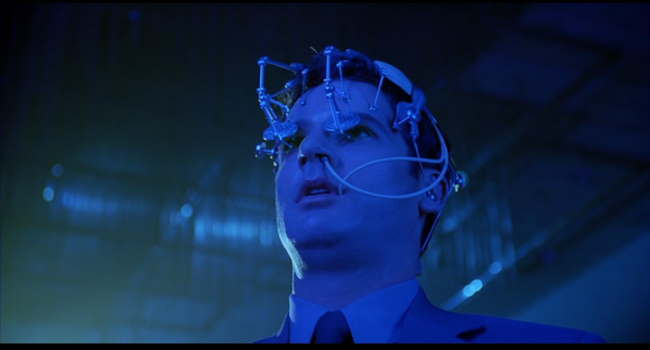
Overview: Canadian film maker Vincenzo Natali, master of doing more with less, delivers us an excellent cyberpunk flick for a virtual pittance budget. At 7.5 million, Cypher is FAR more polished than it has any right to be. This paranoid conspiracy, near-future espionage thriller provides a continual stream of mindfuck moments. Expect your head to get jerked around so much that you’ll need to check yourself for whiplash after watching it.
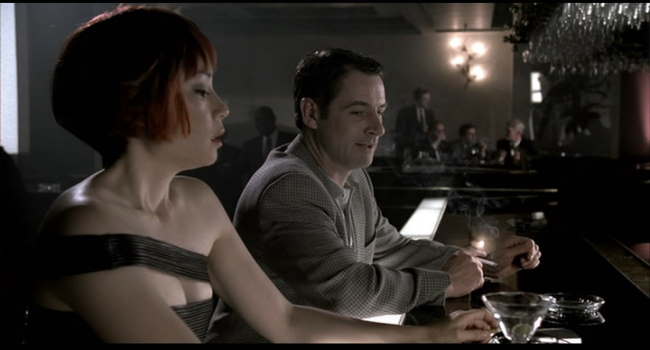
The Story: Jeremy Northam stars as Morgan Sullivan, a nerdy and slightly incompetent salesman who leads a bland life. His job is boring, his nagging wife is overbearing, and he spends most of his time yearning for some excitement to infiltrate his mundane life. In pursuit of this, Morgan applies for a job at Digicorp, a high-tech company, to become a corporate spy. But so far, the job is not the excitement he was looking for. The job involves assuming an fake identity, and then traveling to various non-envious US destinations and secretly recording boring conference speeches.
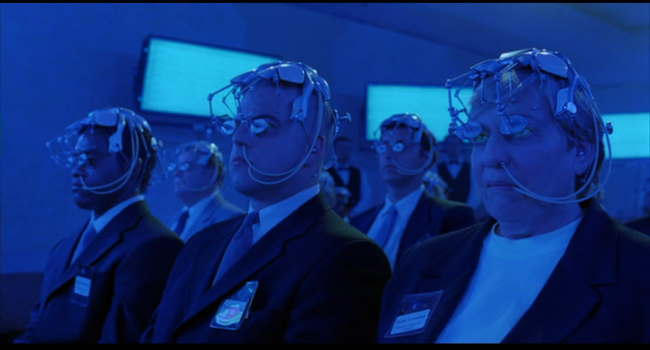
Morgan, now calling himself “Jack Thursby,” develops a persona associated with the name he’s given by Digicorp. He starts to imagine himself to be a suave and sophisticated player, who likes to smoke, drink scotch and pick up sexy women at hotel bars. During one trip he meets Rita Foster (Lucy Liu), who claims to work for a freelance expert named Sabastian Rook. She warns him that he is being brainwashed by Digicorp in order to infiltrate their rival company, Sunways Corporation.
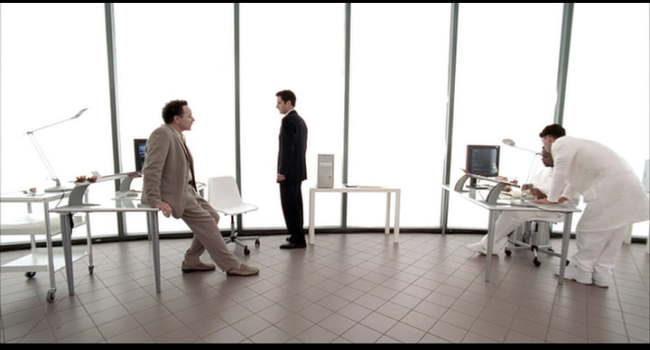
From there, the story becomes too complex to try explaining. The plot reveals layer upon layer of unraveling truth and reality. Morgan realizes he has become enmeshed in an ongoing high stakes corporate battle, and worse, events have so overtaken him that he has nowhere to turn and can trust nobody. Everyone wants to use him for their own purposes, as Morgan, while still a pawn in the larger scheme of things, has come into play.

The Acting: Jeremy Northam, a British character actor, is simply brilliant at acting completely different personas over the course of the movie. He really nails a role requiring complex and diverse acting. Lucy Lui plays a terrific femme fatale who leads Morgan further down into the abyss. The rest of the cast also holds up well, including Nigel Bennett as Digicorp’s mysterious representative, and David Hewlett, who plays a completely bizarre character who lives in a data vault.
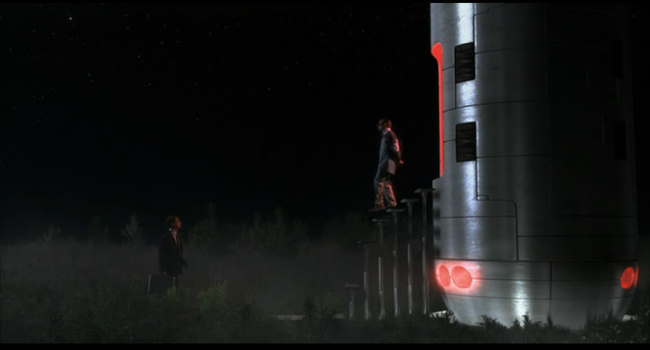
The FX: Truly, I’m blown away that Natali is able to pull over as many special effects as he has with a 7.5 million dollar production budget. The brainwashing headsets are clearly the highpoint of the movie, but many of the effects throughout are muted, but important. In looking at Cypher, most would conclude that this should have taken at least 25 million or so, and even then, they would have needed to watch costs. The range of sets, and completely different looks staggers the mind when the overall cost is presented. Make no mistake – I’m not comparing Cypher to big budget fares like the Matrix, but for the money, Cypher’s FX really look terrific. More importantly, they add important touches in bringing a near-future feel to an otherwise modern day setting.
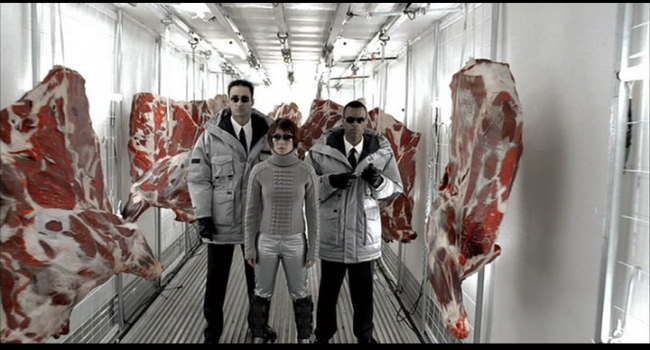
The Bottom Line: In many ways, Cypher comes across as a cyberpunk version of Hitchcock’s North by Northwest. The pacing and feel of Cypher is very similar, and in both movies, you really never know what’s coming around the next corner, but most assuredly it will involve more layers of out-of-control untruths. With all the goodness that Cypher gives us, you’d almost expect the final score to be a 9 or 10. But unfortunately, Cypher’s story falls apart at the end. The technical believability, which is decently high throughout the film, flat-out does a belly flop at the end, and expects us to buy something that anyone who knows a whit about data security, just can’t stomach (I can add a spoiler page on this if anyone is interested). However, this sore point is not enough to sap enjoyment out of an otherwise wonderfully made film. You may not have heard of Cypher, but this is not an indication of its quality. Give it a go – chances are you’ll love it!
~See movies similar to this one~
Year: 2002
Directed by: Si-myung Lee
Written by: Sang-hak Lee & Si-myung Lee
IMDB Reference
Degree of Cyberpunk Visuals: Low
Correlation to Cyberpunk Themes: Medium
Key Cast Members:
Sakamoto Masayuki: Dong-Kun Jang
Saigo Shojiro: Tôru Nakamura
Hye-Rin Oh: Jin-ho Seo
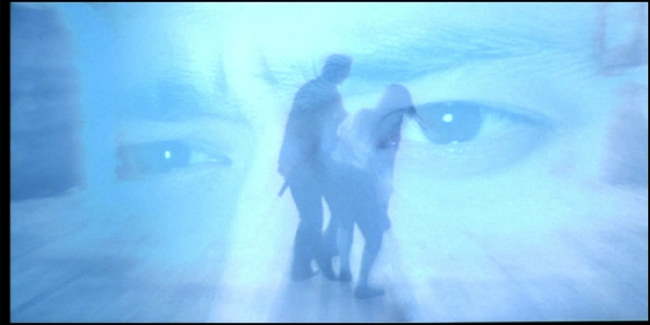
Overview: In yet another very well made Korean Sci-Fi movie, we have a terrific story, great acting, and a wonderfully unfolding secret that really adds to the suspense. 2009: Lost Memories is one of the best Time Travel movies out, and takes place almost completely within an alternate timeline. In this alternate reality timeline, Korea is a Japanese territory called Choson. The primary language of Choson is Japanese, and although the natives still speak Korean in private, they speak Japanese in the course of normal operations. Japan won WWII, and the atomic bombs were dropped on Germany. The Furei-Senjin (Choson Libration Army) are the last ones alive who know that the timeline has been tampered with, and will do whatever is necessary to set things right.
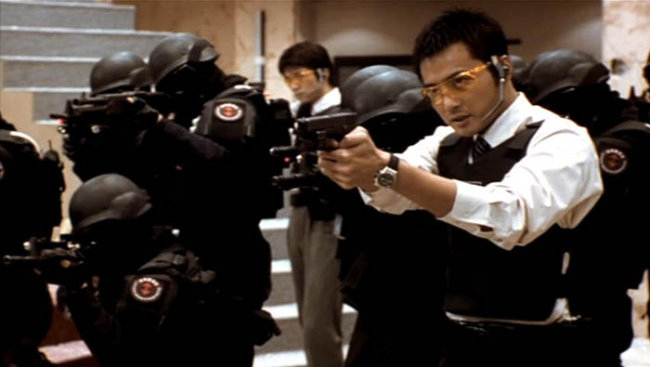
The Story: Sakamoto Masayuki and his partner and best friend, Saigo Shojirou are police officers living in Choson (a province owned by Japan that we know as Korea) who are investigating and confronting the terrorist organization called the Furei-Senjin. Sakamoto discovers that the Furei-Senjin have been after a crescent shaped stone called the Lunar Soul - an ancient artifact purported to have the soul of the moon in it. In pursuing the story, a number of different strands in Sakamoto’s life start to fall into place.
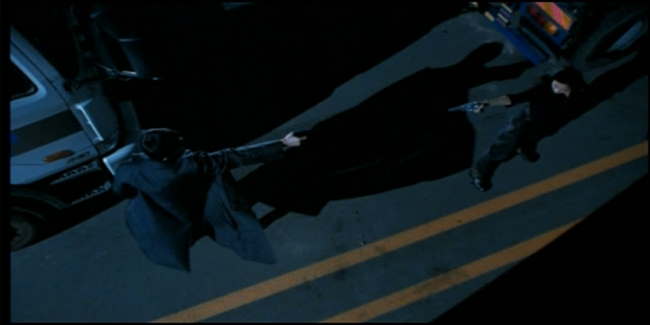
For most of his adult life, Sakamoto has a recurring dream about a beautiful woman he has never met - she has a crescent necklace, and in the dream, they shoot someone. Sakamoto knows he is in love with this woman, and, for some reason, thinks they are destined to be together. During the second confrontation with the Furei-Senjin, he meets this woman - it turns out that Oh Hae-rin (the woman from his dreams, played by Seo Jin-ho) is in fact a leader of the Furei-Senjin. She too feels the connection, and stops her followers from killing Sakamoto when they get the chance.
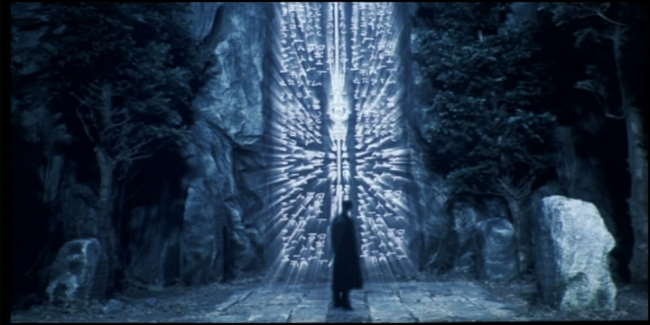
Through his investigation, Sakamoto discovers that back in 1909, in the area surrounding Harbin, there was an attempted assassination of Ito Hirobumi (http://en.wikipedia.org/wiki/Ito_Hirobumi), a prominent Japanese politician back than, and Japan’s first Resident General of Korea following the Russo-Japanese War (which Japan used to occupy Korea). This assassination was prevented by Inoue, an unknown soldier, who was later rewarded for his feat by becoming the second Governor. The Inoue Foundation has spent the last century collecting all artifacts from the 1909 time period.

In following the trail, Sakamoto learns too much, and is framed for the murder of a fellow police officer. Sakamoto eventually discovers that history was altered at that moment, and that Hirobumi was supposed to die that day, and that there never should have been an Inoue back in Harbin on that day. This leads him to the astonishing revelation that the Furei-Senjin are actually the last group alive aware of this tragedy, and that they are trying to restore the proper world timeline. As the movie develops, Sakamoto and his partner become enmeshed on opposite sides of this timeline struggle.
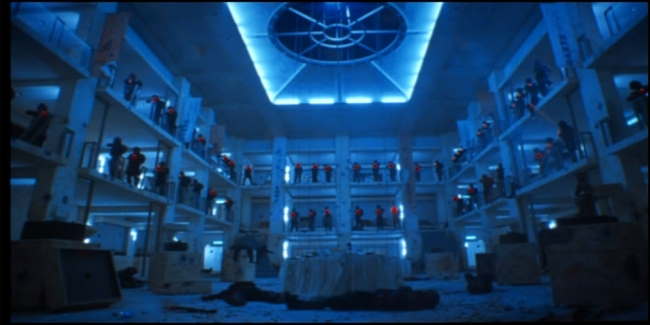
Cost of Entry For Understanding: There is a cost of entry to understanding 2009: Lost Memories. It helps if you recognize the difference between Japanese and Korean Characters. Japanese characters are pictoral in nature, whereas Korean characters look like boxes, half-boxes (L-shaped characters) and circles. This is significant especially at the beginning. The other important element is to know which language they are speaking. Sakamoto is Korean, whereas his partner, Saigo Shojirou is Japanese. The importance and meaning of the scenes is often given away when they switch over to speaking Korean (most of the movie’s “public” scenes are in Japanese). For instance, when Sakamoto is with his uncle, he ALWAYS speaks Korean. Also important to know is the latent hatred that still exists in Korea towards Japan for the time they were occupied (up until WWII). To Koreans, this movie will come off as far more emotional than for foreigners.
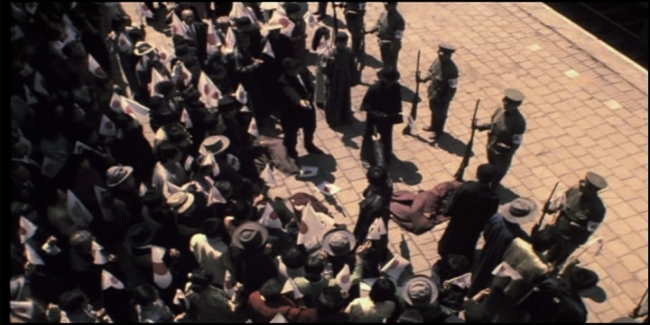
The Bottom Line: 2009: Lost Memories is a very intelligent Korean sci-fi film. I include it as cyberpunk primarily for the wonderfully done time-travel theme done in the very near-future. Te intense confrontation between the best friends that occurs as this movie develops is just terrific. The visuals are all high-tech current visuals though - they are not futuristic in most of the cyberpunk sense. But the world they create is cyberpunk in the sense that it depicts a reality changed by a future traveler to a past time. Also interesting is the notion, that even during a “time-shift” souls might potentially “know” something is amiss.
~See movies similar to this one~
Year: 2006
Directed by: Kurt Wimmer
Written by: Kurt Wimmer
IMDB Reference
Degree of Cyberpunk Visuals: High
Correlation to Cyberpunk Themes: Low
Key Cast Members:
- Violet: Milla Jovovich
- Six: Cameron Bright
- Garth: William Fichtner
- Daxus: Nick Chinlund
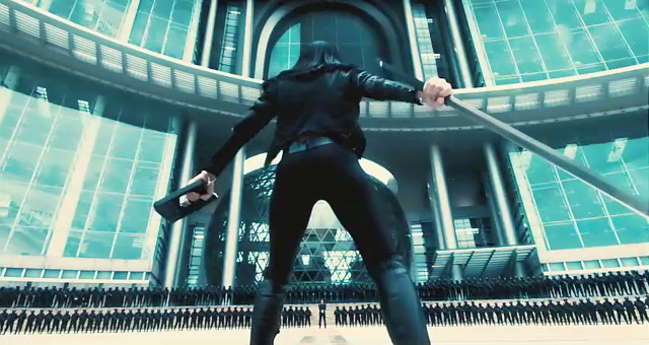
Overview: Ultraviolet is the ultimate example of style over substance. At every juncture, the goal is to create a futuristic music video piece more than it is to convey an interesting story. That said, some of the visuals are pretty damn cool! The pacing generally tries to stay fast enough to help the viewer forget about the plot holes, and even though the overall movie is predictable, you still find yourself smiling in spite of yourself and enjoying some of the way over-the-top fight scenes.
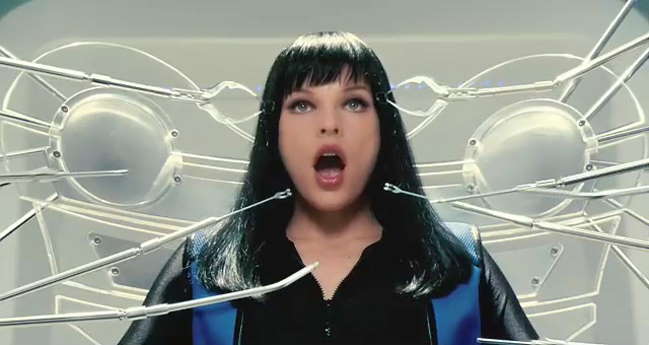
The Story: Ultraviolet takes place in the near-future, a time where terrorism is no longer the scourge of society – now it’s viruses. The worst virus is one that turns humans into Hemophages - this virus, created in a laboratory designed to create super-soldiers, is now air-borne, and has forced the population to take extreme precautions including wearing bird-flu virus masks at all times. Hemophages have vampire-like teeth and been genetically modified, giving them enhanced speed, incredible stamina and acute intelligence. Unfortunately, with these extra-human capabilities, they need blood to replenish themselves (this is barely mentioned in the movie), and their bodies slowly wasteaway.

To the government’s dismay, more and more of the population are being transformed, and, as a civil war looms, they have set out to rid the world of this new race that they now deem menaces to society. Violet, a former nurse at the facility, ended up losing her husband and unborn child when she accidentally contracted the virus. After being a live ginea-pig for the Medical control facility (who also control the new secret police force), Violet escapes and joins the underground Hemophage resistance in attempting to overthrow the medical control police, who are led by their Arch Cardinal, Daxus (played by Nick Chinlund) – and yes, the evil Christian symbolism is in full force here.
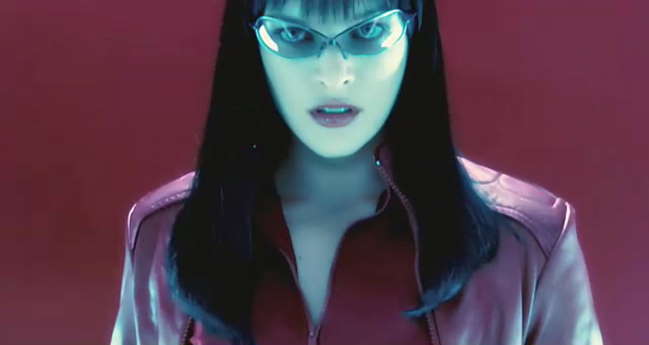
Although Violet has entered the last stages of her sickness, she is given one more mission – to capture the Medical Control’s latest weapon from their headquarter facility and either bring it back or destroy it. After some insane action and escape sequences, Violet succeeds, but discovers that the “weapon” is in fact a small boy named “six” (Cameron Bright). This boy supposedly has genetically altered blood that, if released in the atmosphere, will wipe out all hemophages forever. Her maternal instincts kick and, and she betrays the Hemophage resistance, and is no pursued by both the resistance and the police. The only one she can turn to is her trusted friend and genetic doctor, Garth (played by William Fichtner). But the boy is dying and all options appear hopeless. Because of this, Violet (and the audience) continually says, “What am I doing?”
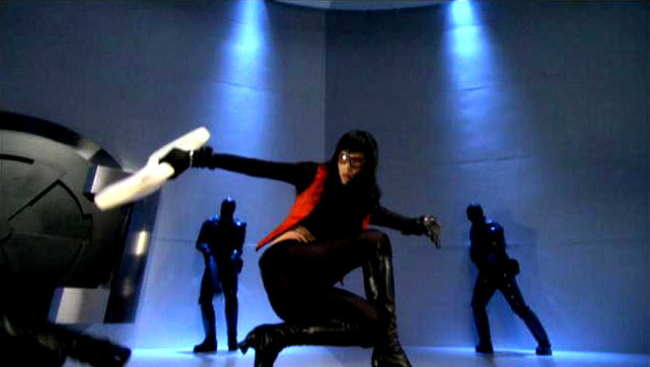
The Action – Gun-kata is Back! Equilibrium fans will be happy to see Gun-kata return with a vengeance. Mila Jovovich generally looks terrific doing it – better than Christian Bale (her belly, which is always visible when kicking butt is definitely CUTE!). It’s clear that Mila has trained hard for the part, and looks good on both the gun and sword fight scenes. The problem though is that an unbelievable MI:2 feeling saturates the action scenes. Mila’s powers border on supernatural, and her nazi-like opponents make the OT Storm Troopers seem like special forces! They are ALWAYS flat-out incompetent in every way possible. Additionally, even though it looks cool, there is never a reason for the sword fights which becomes all the more apparent when, literally seconds later, people come in with Uzzis and spray bullets everywhere.
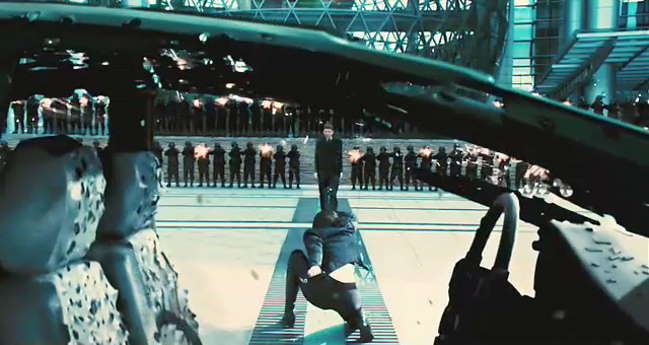
The FX: The FX in Ultraviolet are truly hit or miss. It appears as if pretty much the whole movie (or vast chunks of it) has been filmed on blue-green screens. This in itself is not a problem. The problem comes in that some scenes are rendered wonderfully while others come off as half done. It’s almost as if they ran out of money during the post-production phase and had to wrap up what they had and package it as best they could. This is a shame because the shots that are completed look wonderful. The attention paid to the colors palettes in virtually every seen is extraodinary. Sometimes I caught myself staring slack-jawed in enjoyment; yet others I was almost holding my nose in disgust.
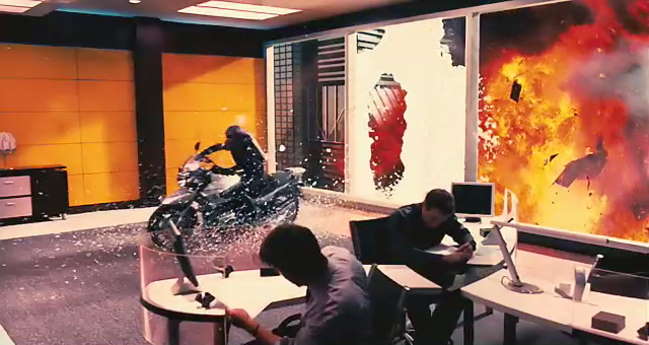
The Soundtrack: From beginning to end, Ultraviolet plays like a music video. You get awesome action mixed with high-energy soundtracks. Sometimes you get the wasping highpitched chants, similar to Gladiator or MI:2, and for other scenes, we get bass-thumping, percussive tracks which help move the action along.
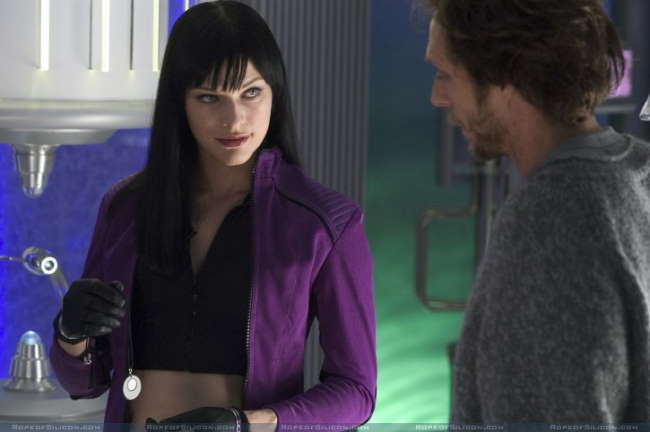
The Acting: Both Jovovich and Cameron Bright are serviceable. William Fichtner is decent for the little screentime he has, but Nick Chinlund is just sour. He has a constant snear, and his performance continually serves to solidify the already one-dimensional “evil bad guy” nature of his character. But truly, Wimmer just does not give his stars much to work from. Virtually the entire story is a sequence of visuals. While Jovovich seems to excel in this mode, keeping mostly believable facial expressions for the bulk of her acting, Chinlund pretty much sucks at it, and seems to struggle in finding the appropriate demeanor.
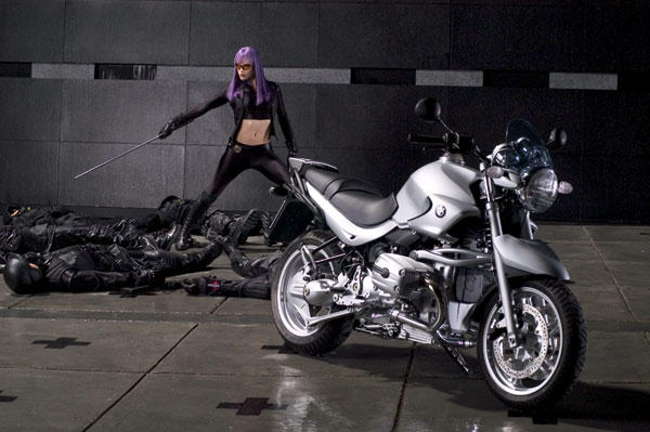
What’s Missing? The whole front end of the story for Ultraviolet seems to have been cut, and in its place, we get a synopsis similar to what we see on TV shows recapping episodes that related to the current episode (e.g., “Previously, on Lost….”). Truly, the amount of time it took you to read my two paragraphs above on the story equals the amount of time they devoted to the front-end exposition. It looks like a good 20 minutes or so was boiled down into a 2 minute quick-cut scene to allow us to jump into the action headfirst. But by doing so (again, I’d bet money that this stuff was shot, and furthermore, that we get it on an extended DVD), Ultraviolet significantly cheapens an already weak storyline. Any depth in the characters are lost. Additionally, some of the adds, the BMW adds in particular, really are a bit too overt.
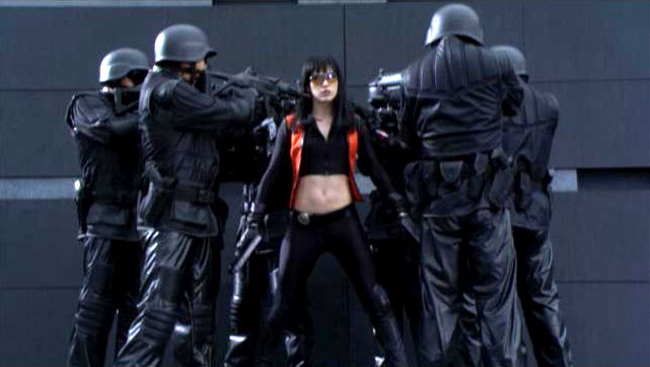
The Gadgets: As weak as the story is, some of the gadgets in Ultraviolet are just awesome! They really do add a pretty fun dimension to the movie. They include things such as:
- Disposable Cell Phone Dispenser: I LOVE the idea of a disposable cell phone dispenser - cell phones are “wafer-thin” and bendable – you insert your credit card, and similar to a paper receipt, a cell phone sheet comes out with a certain number of minutes on it.
- Virtual Storage: Ultraviolet also has a believable looking D&D “Bag of Holding” that can be embedded in the body. I think the idea is that Nanotechnology allows the molecules to break down into some other substance, but can be put back-together into guns and swords.
- Multi-colored clothes: I fully expect this idea to take hold. Similar to the nano-couch in One Point O, clothes and hair in Ultraviolet can change color at will.
- Sunglasses: Yes, Ultraviolet WILL prompt sunglasses sales – bank on it! They are the symbol for “coolness” in movies now, and ultraviolet raises the bar here by making them multifunctional.
- HologramsThe holograms, used to making moving imitations of people, similar to those in Ghost in the Shell, are terrific. Wimmer creates some great “break-up” FX for them that really seem to add to their believability.

The Bottom Line: If you’re looking for cool style over substance, Ultraviolet is one to watch. But while some of the sequences in Ultraviolet are breathtaking, the movie as a whole is not a good one. What little story there is seems to have been lost in editing. Still, some of the visuals are pretty cool, and may be reason enough for you to go watch this. If you’re a Jovovich fan, or want to see more cool Gun-kata scenes, you will enjoy Ultraviolet. But if you’re looking for a deeply textured cyberpunk story, look elsewhere. One point extra granted for the cool gadgets.
Year: 2004
Directed by: Masahiko Maesawa
Written by: Chinfa Kang
IMDB Reference
Degree of Cyberpunk Visuals: Medium
Correlation to Cyberpunk Themes: Low
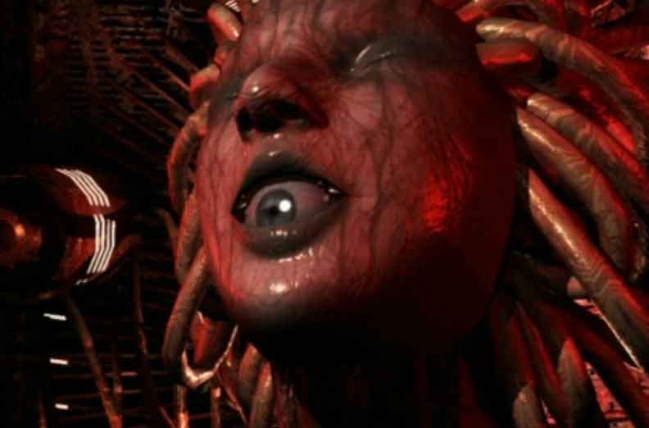
Overview: Galerians Rion is a a low-quality animation - meaning video game quality with a semi-coherent story. Unfortunately, the story too plays like a video game. The star of the video game is a boy named Rion, who wakes up in a bizarre dystopic version of his former world. It turns out that this crazed supercomputer named Dorothy is attempting to become a God and only Rion can stop her. To do so, he needs to find his sister Lilia, who, along with Rion, has been given a virus that combined, can destroy Dorothy. As most RPGs, Rion’s powers grow as he fights the Galerians that Dorothy throws up to block his journey to finding his sister. You can tell the end of the segment, because, um, Rion fights a boss character. Yes, you really are watching someone play a video game here!
The Bottom Line: While I am impressed that Maesawa was able to produce an anime on such a limited budget (I’m guessing a game environment was used to make most of the visuals other than Dorothy), they just aren’t good enough to make for compelling viewing. The visuals are rather fascinating in places - Dorothy (see above) is pretty cool for instance - and certainly are cyberpunk, as is the story, but there just isn’t enough here, either in story or visuals to make this worth recommending. I will give it a point for attempting to do a full scale anime without a budget.
~See movies similar to this one~
Year: 2001
Directed by: Rintaro
Written by: Osamu Tezuka, Katsuhiro Ôtomo
IMDB Reference
Degree of Cyberpunk Visuals: High
Correlation to Cyberpunk Themes: High
Key Cast Members:
Tima (voice): Yuka Imoto
Kenichi (voice): Kei Kobayashi

Overview: Metropolis is a wonderful anime that, while it shares the same name as a far more famous movie, it is in fact a different story altogether. In this story, also set in an astoundingly beautiful futuristic city, with three tiers of inhabitants - the elite, the human working class, and all the way at the bottom, the slave-like robots. The powerful corporate leader who runs Metropolis, Duke Red, has created a structure called the Ziggurat, a huge tower designed to control all information and machines in the world. To make this possible, he hires Dr. Laughton, a genius criminal scientist to make a an super-android focal point of the Ziggurat, who is designed in the image of his daughter.
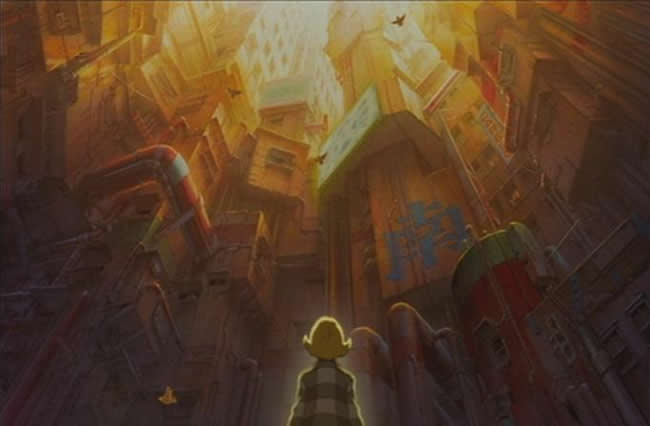
Fortunately for the world, their plans are disrupted when Shinsaku Ban, a detective from Japan, and his nephew Kenichi, arrive to track down and capture Dr. Laughton. They disrupt the “birthing” of the super-android, called Tima, and destroy the lab. In the ensuing chaos, Kenichi finds Tima, and thinking her human, rescues her from the destruction. They become separated from Separated from his uncle, and begin a journey of discovery in the lower levels of Metropolis.
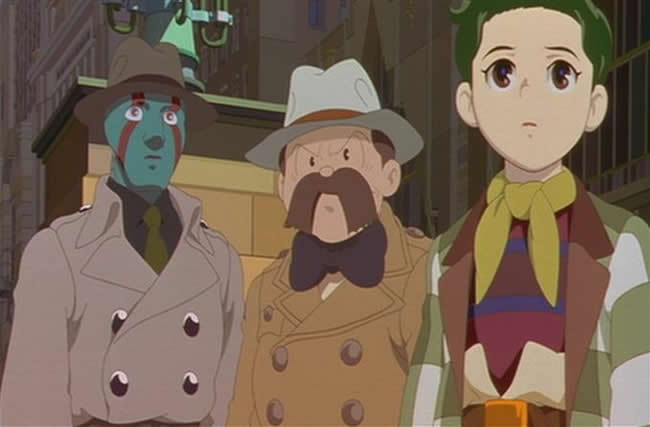
Eventually, Duke Red learns that his super-android is alive and well, and dedicates everything to catch her. Over the course of the movie, Tima begins to learn her true nefarious purpose, while at the same time, begins to fall in love with Kinichi. This becomes a story of questioning what is humanity, and whether robots can be loved and treated like humans, or whether they are machines to be used for our purposes.
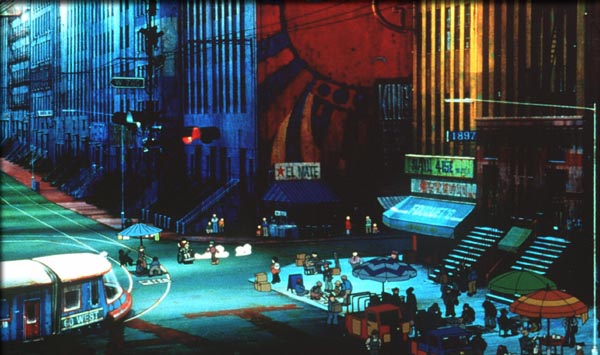
The Visuals and Sound: The visuals in metropolis are both varied and often astounding. We get a wonderful mix of 2D-3D graphics - unlike most movies, they are definitely weighted towards the 2D side. And I love how Metropolis makes the change in colors from almost a pastel-type opening to dark and dirty colors as the movie progresses. This is very similar to how Transmetropolitan does it in graphic novels. The characters are done in an interesting style, with almost completely round heads. This is disconcerting at first, but eventually you get used to it. And top top if off, we get some of the most wonderful use fo music in an anime. Some of the old fashioned Jazz tunes in here create a wonderful retro-type mood that really seems to fit.

The Bottom Line: Metropolis is a terrific little anime, although I would have liked to have seen a few parts of the script flushed out a bit more. Still, I love the movie, but it’s the ending that makes it for me. Tima’s question at the end pretty much sums up the purpose of the movie. This is a really nice exploration into the nature of humanity thing from a cyberpunk film standpoint.
~See movies similar to this one~
Tags: cyberpunk movie review anime metropolis
Year: 2000
Directed by: Mark Neale
Written by: Mark Neale
IMDB Reference
Degree of Cyberpunk Visuals: Very Low
Correlation to Cyberpunk Themes: Low
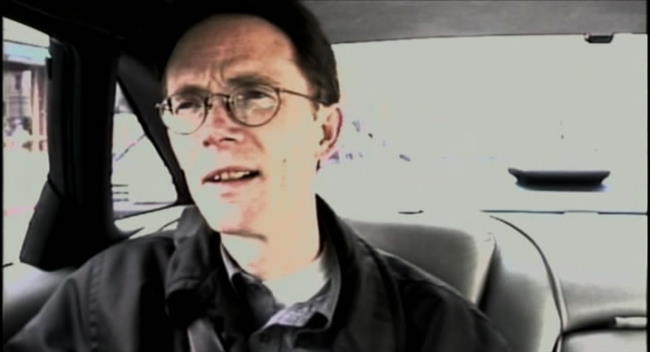
Overview: I notice the decent IMDB rating for No Maps, but honestly, I just don’t see it. I have hard time coming up with something positive to say as No Maps for These Territories as a documentary on Gibson fails in virtually all aspects possible. You have to look long and hard to find a documentary with this little attention to detail across the board. No Maps has horrible lighting, haphazard editing and “FX” choices which detract even more from the mess that’s already on screen. In short, this film seems to be sending the message that William Gibson is a meandering scatterbrain who occasionally comes up with an interesting idea or two, but who, for reasons not of his own making, was able to become wildly popular. None of this is true of course, which is why this documentary resonates so badly with me.
Because I also gave New Rose Hotel a horrible rating, I want to be VERY clear about something – I think William Gibson is one of the most influential writers of the later part of the 20th century. His stuff is better than great. In no way does my knocking these movies reflect at all on my opinion of his literary works or his legacy. Nor do I believe that Gibson’s works cannot be very successfully transferred on-screen. Unfortunately, Gibson has yet to find his Peter Jackson.
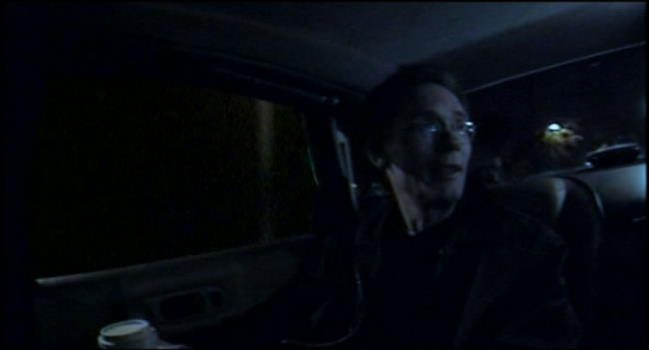
I’m guessing the cup is a prop to get more light into the picture…
The Setting: A significant part of my dislike for No Maps is based on the decision to use a car as the setting. In thinking about it, it’s really hard to imagine a worse way to conduct a documentary. The entire thing takes place with Mark Neale, the director, driving a car while talking to Gibson, who is in the back seat surrounded by a few of set cameras. In using this approach, Neale was able to generate the worst of all scenarios:
- Neale has to focus on driving so he has absolutely NO control over the cameras. This continually leads to horribly over or under-exposed shots of Gibson, grainy, and out of focus film and horrible positioning.
- Because Neale has to concentrate on driving, whatever skills he might have had as an interviewer are compromised by the fact that he’s in massive multitasking mode – he’s driving and continually checking the recording while attempting conducting an interview. My guess is after a while, Neale just wanted to make sure Gibson was talking, and stopped bothering listening to what was being said.
- Every now and then, Gibson would utter a terrific insight, such as when he mentioned that the internet all but ensured the end of the nation state. This would have been a great time for a prompting follow-up from an astute interviewer, but unfortunately, we get absolutely NO follow-up on this and many similar fascinating comments.
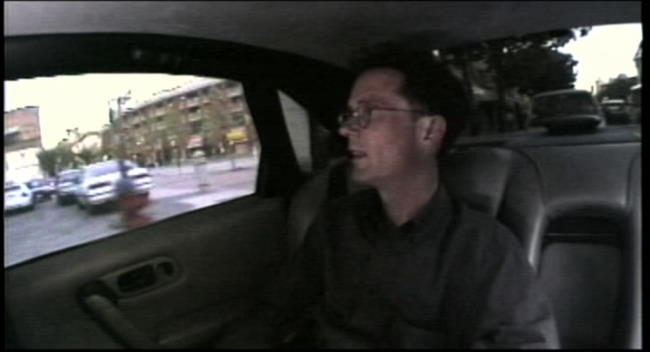
Notice that the left window scene doesn’t match with the rear window - this was intentional.
What the Cinematography Conveyed: Probably the most dissapointing aspect of No Maps relates to the unintentional visual symbols the “road trip” documentary provided. Gibson is known as a trailblazer – a thought leader in setting the course for science fiction, yet the interview in the back of the car makes him seem like someone happy to follow along someone else’s path. The title, “No Maps for These Territories ” is supposed to convey that Gibson went into un-chartered waters, yet everything in this documentary, from the meandering and repetitive music to the monotonous car ride, makes Gibson come across as someone who basically just intellectually wanders around and hopes he happens upon something interesting. In short – there was a map of the territory – it was in Gibson’s mind. This film works hard to obfuscates that fact:
- The constant penchant to splice in absolutely random images in rapid succession whenever Gibson philosophizes tends to make Gibson’s message come off as incoherent.
- The repetitive music consistenty has this meandering quality, which again, reinforces the message that Gibson wanders around through life and occaisionally gets lucky.
- The “special effects” where Neale haphazardly transferred separate drive-by the images onto the side and rear window and back side of the car so that what was coming through rear window no longer matched the side window (see image directly above for an example) served NO PURPOSE AT ALL other than to distract the viewer from Gibson’s oratory.
- The complete inattention to lighting or setting makes the entire project comparable to a neighbor’s home movie. It’s almost as if Neale was consciously trying to make Gibson (and Sterling) look as shabby as possible with the hopes that it made them more “edgy” or “real.” If this was the intent, my apologies for missing how this was helpful.
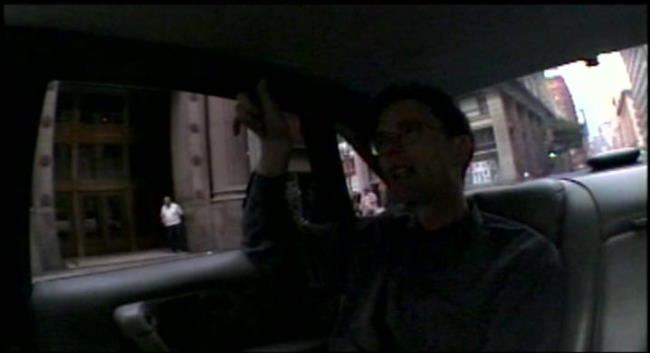
No, I didn’t have to look hard to find quality lighting shots like this one.
Perhaps the goal was either to break up the monotony of staring at Gibson in a back seat of a car for 88 minutes, or maybe it was done with the hope of making Gibson’s oratory seem non-linear, but what seems to be conveyed is that Gibson’s ideas aren’t really connected in any real way. In line with this, Gibson as the “meanderer” is re-enforced by poor editing decisions. While a few segments such as the internet one seem to have a nice flow, most segments are all over the non-existent map. What Neale unintentionally seems to convey is that if you keep a camera on Gibson long enough, like the rest of us, he’ll eventually come up with a a number of half-formed, off-the-cuff comments that go absolutely nowhere.
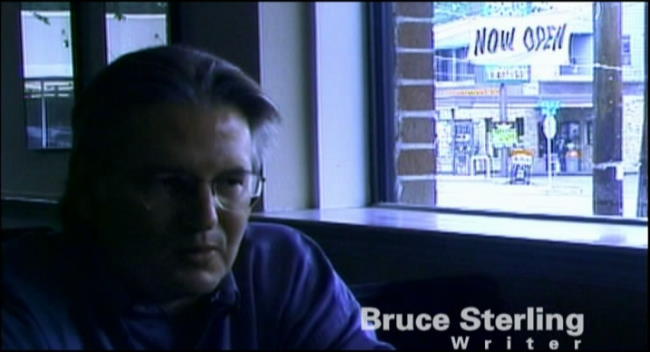
Was this shot intentional? Does Mr. Sterling own a gas station and like Marlboros? If so, probably they should have worked the camera better, as often only half of the gas station is showing.
Neuromancer’s Legacy: One thing we do learn from No Maps is that Gibson, like many great innovators, is probably the worst person to talk about his place in history, and in particular, the relevance of his earlier works like Neuromancer. When it comes to discussing his legacy, Gibson is extremely modest. He’s also a perfectionist when it comes to evaluating his prose. As he gets older, he negatively judges his earlier and discounts their value and overall importance. In discussing Neuromancer, Gibson calls it a simplistic book – as simplistic as cheesy three-chord progression songs in Album Oriented Rock music in fact, and that only teenage Goths should ever find it appealing. Never mind that it won all possible scifi awards (Hugo Award, Philip K. Dick Memorial Award, Nebula Award, Seiun Award, and Ditmar Award) and defined a whole new genre of science fiction, or that it changed the vocabulary and concepts the world over (the concept of cyberspace, for instance), Gibson still considers it pretty sophomoric. This leads to the clear implication that those who see something more in Neuromancer, or any of his 80s works, are also of the intellectual caliber of teenage Goths. Yet, in his five minute interview at a cheesy restaurant (also with shitty lighting), Bruce Sterling is able to provide more context on Neuromancer’s place in history than Gibson does for the rest of the film. Sterling points out clearly that while Gibson as an older man looking back at his life may have the right to criticize himself, but this doesn’t change the fact that he was a damn good writer back then who transformed the face of science fiction – I only wish there was an interviewer in this capable of pinning Gibson down on this. While Gibson may or may not like the prose, the ideas proposed clearly had intrinsic worth, and every so often, even Gibson acknowledges this.

This shot, which we see quite frequently in No Maps, perfectly sums up the documentary.
The Bottom Line: On the whole, this documentary performed a disservice to Gibson and his legacy. Those who have never been exposed to Gibson will watch this and conclude that Gibson was a lucky bystander in history who seemed to be at the right place at the right time. If you’re already a Gibson fan, you may get a bunch of interesting and honest tidbits from his past, but little else will be gained. In watching No Maps, I really found myself wishing that Neale had just gotten a semi-decent interviewer to sit down with Gibson in a quiet setting and interview him. Also, far more time should have been given to Gibson’s contemporaries, who clearly have a better sense of Gibson’s significants than he does. Had Neale taken this approach (one might call this a traditional documentary approach for lack of a better description), the result would have been FAR superior to the mess that this documentary produced. Again, the problem wasn’t that No Maps was produced on a shoestring budget, the problems arose from the choices made (using a moving car as the setting, where the director/interviewer/cameraman/driver was one in the same person, and the subsequent editing decisions). Yes, the name of the documentary is VERY cool, but very little else should be saved. Gibson deserves better. If history is kind, No Maps will be forgotten, and at some point, a quality documentary will be made that highlights Gibson’s most impressive legacy.
~See movies similar to this one~
Tags: cyberpunk movie review Gibson Territory Maps
|




































































